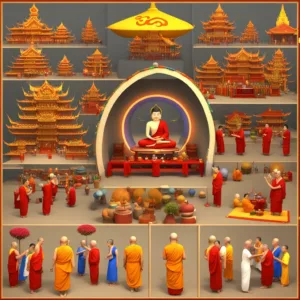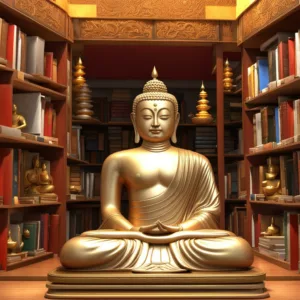OM MANI PADME HUM, the mantra of compassion, is a Sanskrit mantra for Hinduism and Buddhism, including Tibetan forms. It means Jewel in the Lotus, signifying compassion and wisdom arising together.
Table of Contents

OM MANI PADME HUM
The Sacred Chant that Awakens Inner Peace
Introduction
Om Mani Padme Hum is a sacred mantra in Tibetan Buddhism. It is a six-syllable mantra that is believed to contain the essence of all Buddhist teachings. The mantra is associated with the bodhisattva of compassion, Avalokiteshvara, and is chanted to invoke his blessings and cultivate compassion and wisdom. It is considered one of the most powerful mantras in Buddhism and is widely recited by Buddhists around the world.
OM MANI PADME HUM meaning
OM MANI PADME HUM meaning in Hindi
OM MANI PADME HUM Meaning in English
OM MANI PADME HUM benefits
Om Mani Padme Hum benefits for those who chant it. Chanting Om Mani Padme Hum purifies and cleanses the mind. By repeating the mantra, individuals release negative thoughts and emotions, allowing for a greater sense of peace and clarity. This purification of the mind can lead to a reduction in stress and anxiety, as well as an increase in overall well-being.
Furthermore, Om Mani Padme Hum is believed to have the power to transform negative karma into positive karma. Karma is the law of cause and effect, and it is believed that our actions in this life and past lives can create negative or positive karma. By chanting this mantra, individuals can purify their negative karma and create positive karma, leading to a more positive and fulfilling life.
Another benefit of Om Mani Padme Hum is its ability to cultivate compassion and loving-kindness. The mantra is associated with Avalokiteshvara, the bodhisattva of compassion, and by chanting it, individuals can connect with and embody the qualities of compassion and love. This can lead to a greater sense of empathy and understanding towards others, as well as an increased desire to help alleviate the suffering of all beings.
Moreover, chanting Om Mani Padme Hum can also deepen one’s spiritual practice. The mantra is considered a sacred sound that can help individuals connect with their higher selves and the divine. By chanting this mantra with devotion and sincerity, individuals can experience a deep sense of spiritual connection and transcendence.
In conclusion, chanting Om Mani Padme Hum holds numerous benefits for those who practice it. From purifying the mind and body to transforming negative karma and cultivating compassion, this mantra has the power to bring about positive change in one’s life. Whether you are seeking mental clarity, physical healing, or spiritual growth, chanting Om Mani Padme Hum can be a powerful tool on your journey. So, take a moment, close your eyes, and let the sacred sound of this mantra guide you towards a greater sense of peace, love, and enlightenment.
OM MANI PADME HUM Tibetan
Om Mani Padme Hum is a powerful mantra that holds great significance in Tibetan Buddhism. This mantra is often chanted or recited by Buddhists as a way to invoke the blessings and compassion of Avalokiteshvara, the bodhisattva of compassion. The mantra holds the power to purify negative karma, bring about inner peace, and ultimately lead to enlightenment.
The mantra itself is composed of six syllables: Om, Ma, Ni, Pad, Me, and Hum. Each syllable holds its own meaning and represents different aspects of the Buddhist path. The syllable “Om” is considered to be the sacred sound of the universe, representing the body, speech, and mind of all enlightened beings. It is the sound that encompasses everything and connects us to the divine.
The syllables “Ma” and “Ni” represent the two aspects of method and wisdom, which are essential in the practice of Buddhism. Method refers to the compassionate actions we take to benefit others, while wisdom refers to the understanding of the true nature of reality. These two aspects are seen as inseparable and necessary for spiritual growth.
The syllables “Pad” and “Me” represent the lotus flower, which is a symbol of purity and spiritual awakening. The lotus grows in muddy waters but remains untainted by its surroundings, just as we can cultivate inner purity and wisdom amidst the challenges of life. The lotus also represents the blossoming of our own potential and the realization of our true nature.
The final syllable, “Hum,” represents indivisibility and unity. It signifies the inseparability of wisdom and compassion, as well as the union of the practitioner and the deity. It reminds us that we are not separate from the enlightened beings we seek to emulate, but rather, we have the potential to awaken the same qualities within ourselves.
How to meditate like a yogi
and enter profound samadhi
When chanting or reciting the mantra, it is important to do so with mindfulness and intention. The repetition of the mantra helps to focus the mind and cultivate a sense of inner peace and clarity. It is believed that the vibrations created by the chanting of the mantra have a transformative effect on our consciousness, purifying negative emotions and thoughts.
The mantra can be chanted aloud or silently, depending on personal preference. Some practitioners choose to use prayer beads, known as a mala, to keep track of the repetitions. The mantra can be recited as a daily practice or during times of difficulty or distress, as a way to invoke the compassionate energy of Avalokiteshvara.
In Tibetan Buddhism, the mantra is considered to be so powerful that it is believed to have the ability to benefit not only the person reciting it but also all beings in the surrounding environment. It is seen as a universal prayer for peace and compassion, transcending individual boundaries and connecting us to the greater web of existence.
In conclusion, Om Mani Padme Hum is a sacred mantra that holds deep meaning and significance in Tibetan Buddhism. Its six syllables represent different aspects of the Buddhist path and serve as a powerful tool for purifying negative karma, cultivating inner peace, and ultimately attaining enlightenment. Whether chanted aloud or silently, this mantra has the potential to transform our consciousness and bring about positive change in ourselves and the world around us.
OM MANI PADME HUM mantra
Om Mani Padme Hum, a profound Buddhist mantra, is revered for its spiritual significance. Chanted to invoke Avalokiteshvara’s compassionate blessings, its six syllables symbolize the realms of existence and the journey to enlightenment.
“Om,” the first syllable, signifies the sacred sound connecting us to the divine, fostering inner peace. “Mani,” the second syllable, symbolizes the altruistic pursuit of enlightenment, akin to a radiant jewel bringing joy to all. “Padme,” the third syllable, translates to the lotus flower, representing purity and spiritual growth.
“Hum,” the fourth syllable, denotes unity of wisdom and compassion, essential for spiritual growth. Each syllable has distinct benefits: “Om” purifies, “Mani” enhances compassion, “Padme” cultivates wisdom, and “Hum” overcomes obstacles.
OM MANI PADME HUM translation
Om Mani Padme Hum is a powerful mantra that holds deep significance in the Buddhist tradition. Translated from Sanskrit, it means “Hail to the Jewel in the Lotus.” This mantra is often chanted or recited by Buddhists as a way to invoke the blessings of Avalokiteshvara, the bodhisattva of compassion.
The translation of Om Mani Padme Hum is not a simple task, as each word carries multiple layers of meaning. However, a direct translation of the mantra can be understood as “Om, the jewel in the lotus, hum.” This translation captures the essence of the mantra, which is a profound invocation of compassion and wisdom.
The word “Om” is a sacred syllable in Hinduism and Buddhism, representing the primordial sound of the universe. It is often used at the beginning and end of prayers and mantras to connect with the divine. In the context of Om Mani Padme Hum, it serves as a powerful opening to the mantra, setting the stage for the invocation of compassion and wisdom.



“Mani” translates to “jewel” or “gem” in English. In Buddhism, the jewel is a symbol of enlightenment and the preciousness of the teachings. It represents the inherent potential for awakening that exists within all beings. By chanting “Mani,” practitioners are reminded of their own inner jewel and the possibility of realizing their true nature.
“Padme” means “lotus” in English. The lotus is a symbol of purity and spiritual awakening in many Eastern traditions. It grows from the muddy depths of a pond, yet remains untouched by the impurities around it. Similarly, the lotus represents the potential for enlightenment that exists within every individual, regardless of their circumstances. Chanting “Padme” reminds practitioners of their own innate purity and the possibility of transcending suffering.
“Hum” is a syllable that represents the indivisible nature of all phenomena. It signifies the union of wisdom and compassion, the two essential qualities on the path to enlightenment. By chanting “Hum,” practitioners are reminded of the inseparable nature of these qualities and their importance in cultivating a compassionate and wise heart.
When reciting Om Mani Padme Hum, practitioners are not only invoking the blessings of Avalokiteshvara but also cultivating these qualities within themselves. The mantra serves as a powerful tool for purifying the mind, opening the heart, and connecting with the compassionate energy of the bodhisattva.
In conclusion, the translation of Om Mani Padme Hum as “Hail to the Jewel in the Lotus” captures the essence of this powerful mantra. Each word holds deep significance and represents a different aspect of the path to enlightenment. By chanting this mantra, practitioners invoke the blessings of Avalokiteshvara and cultivate compassion and wisdom within themselves. Om Mani Padme Hum serves as a reminder of the inherent potential for awakening that exists within all beings and the possibility of transcending suffering.
OM MANI PADME HUM chanting
Om Mani Padme Hum is a powerful mantra that holds deep significance in the Buddhist tradition. Chanting this mantra is believed to bring about profound transformation and spiritual awakening. The words themselves hold immense power and are considered to be a condensed form of the entire Buddhist teachings.
The mantra begins with the syllable “Om,” which is considered to be the primordial sound of the universe. It represents the essence of all creation and is often chanted at the beginning and end of prayers and rituals. The sound of “Om” is said to resonate with the cosmic vibrations, aligning the practitioner with the divine energy that permeates everything.
The next part of the mantra, “Mani Padme,” translates to “jewel in the lotus.” This symbolizes the awakening of the enlightened mind, which is said to be like a precious jewel hidden within the lotus flower. The lotus is a powerful symbol in Buddhism, representing purity, enlightenment, and the potential for spiritual growth. Chanting “Mani Padme” is believed to invoke the qualities of the lotus, helping the practitioner cultivate inner wisdom and compassion.
The final part of the mantra, “Hum,” is a syllable that represents the indivisible union of wisdom and compassion. It is believed to dissolve the ego and awaken the true nature of reality. Chanting “Hum” is said to purify negative emotions and thoughts, allowing the practitioner to experience a deeper sense of peace and clarity.
When chanting Om Mani Padme Hum, it is important to do so with intention and focus. The repetition of the mantra creates a rhythmic vibration that resonates throughout the body and mind, helping to quiet the restless thoughts and distractions of everyday life. By chanting with devotion and concentration, one can enter a state of deep meditation and connect with the divine energy within.
The power of Om Mani Padme Hum lies not only in the words themselves but also in the intention and sincerity of the practitioner. It is not simply a matter of reciting the mantra mechanically but rather of embodying its meaning and allowing it to transform one’s consciousness. Through regular practice, the mantra can become a powerful tool for self-transformation and spiritual growth.
Chanting Om Mani Padme Hum can have a profound impact on one’s life. It can help cultivate qualities such as compassion, wisdom, and inner peace. It can also serve as a reminder to live in alignment with the teachings of Buddhism, which emphasize the importance of kindness, mindfulness, and non-attachment.
In conclusion, Om Mani Padme Hum is a sacred mantra that holds deep spiritual significance in the Buddhist tradition. Chanting this mantra with intention and focus can bring about profound transformation and spiritual awakening. It is a powerful tool for cultivating inner wisdom, compassion, and peace. By incorporating this mantra into our daily practice, we can align ourselves with the divine energy and experience a deeper connection to ourselves and the world around us.
Om Mani Padme Hum – Origin and History
Om Mani Padme Hum is a powerful mantra that holds deep significance in the Buddhist tradition. Its origins can be traced back to ancient India, where it was first chanted by the great Bodhisattva Avalokiteshvara. This mantra has since spread throughout the Buddhist world, becoming one of the most widely recited and revered mantras in existence.
The phrase “Om Mani Padme Hum” is often translated as “Hail to the Jewel in the Lotus.” Each syllable of the mantra carries its own meaning and symbolism, creating a profound and multi-layered message. The syllable “Om” represents the body, speech, and mind of the Buddha, while “Mani” means jewel and symbolizes the factors of enlightenment. “Padme” translates to lotus, which signifies wisdom, and “Hum” represents indivisibility and unity.
The origins of this mantra can be found in the ancient Buddhist scriptures known as the sutras. According to these texts, Avalokiteshvara, the Bodhisattva of Compassion, was moved by the suffering of all beings and vowed to liberate them from their pain. In order to fulfill this vow, Avalokiteshvara sought the guidance of the Buddha Amitabha, who bestowed upon him the mantra “Om Mani Padme Hum.”
From that moment on, Avalokiteshvara began to chant the mantra tirelessly, using its power to alleviate the suffering of all sentient beings. As word of his compassionate actions spread, the mantra gained popularity and became a central practice in the Buddhist tradition.

Flow, the profound mental state, also called Peak Performance, can be attained with meditation and can be ‘triggered’ at will, with enough discipline. Guide to Flow Mastery will teach you how.
Over time, the mantra “Om Mani Padme Hum” spread beyond India and reached other parts of Asia, including Tibet, China, and Japan. In each of these regions, the mantra took on its own unique interpretations and variations, reflecting the diverse cultural and religious practices of the people.
In Tibet, the mantra became particularly significant and was embraced by the Tibetan Buddhist tradition. Tibetan Buddhists believe that reciting the mantra can purify negative karma, accumulate merit, and ultimately lead to enlightenment. The mantra is often chanted during meditation, prayer, and other spiritual practices, with the intention of cultivating compassion and wisdom.
In addition to its spiritual significance, the mantra “Om Mani Padme Hum” has also become a symbol of unity and peace. It is often seen inscribed on prayer flags, carved into rocks, and printed on prayer wheels, serving as a constant reminder of the power of compassion and the interconnectedness of all beings.
Today, the mantra continues to be recited by millions of Buddhists around the world. Its timeless message of compassion and wisdom resonates with people from all walks of life, regardless of their religious or cultural background. Whether chanted silently or spoken aloud, the mantra “Om Mani Padme Hum” serves as a powerful tool for transformation and a source of inspiration for those seeking inner peace and enlightenment.
In conclusion, the mantra “Om Mani Padme Hum” has a rich and ancient history that spans across different cultures and traditions. Its origins can be traced back to the compassionate Bodhisattva Avalokiteshvara, who used the mantra to alleviate the suffering of all beings. Today, this powerful mantra continues to be chanted by millions, serving as a reminder of the interconnectedness of all beings and the transformative power of compassion and wisdom.
Conclusion
In conclusion, Om Mani Padme Hum is a powerful mantra in Tibetan Buddhism that is believed to invoke the blessings of Avalokiteshvara, the bodhisattva of compassion. It is commonly recited or chanted by Buddhists as a means of purifying the mind, cultivating compassion, and attaining enlightenment. The mantra is considered to be a profound expression of the path to liberation and is widely revered and practiced by followers of Tibetan Buddhism.

May all beings be happy
May all beings be peaceful
May all beings be safe
May all beings awaken to the light of their true nature
May all beings be free







